Church of the Immaculate Conception
Cnr Burwood & Glenferrie Roads, Hawthorn
Built 1879 George Fincham
2 manuals, 13 speaking stops, 3 couplers, mechanical action
Rebuilt and enlarged 1965 Geo. Fincham & Sons Pty Ltd
2 manuals, 25 speaking stops, 8 couplers, electro-pneumatic action
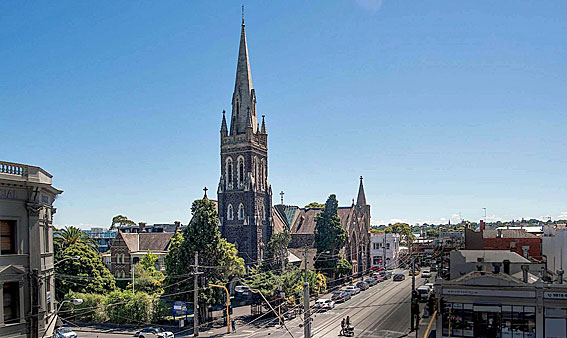
Church of the Immaculate Conception, Hawthorn: exterior from south-east taken from the Town Hall
(photograph kindly supplied by the church)
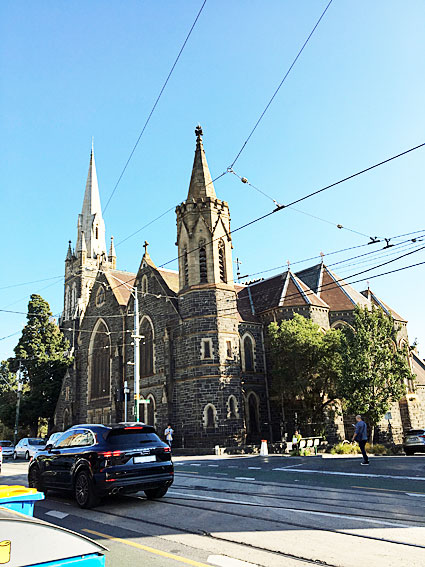
Church of the Immaculate Conception, Hawthorn: exterior from north-east showing the 1892 choir and organ loft, stair turret and the three apses
(photograph by John Maidment [May 2019])
Historical and Technical Documentation by John Maidment
© OHTA, 2019 (last updated May 2019)
The first part of the present church was built between 1867 and 1869 to the design of Melbourne architects Crouch & Wilson who won the commission as part of an architectural competition. The first section comprised four bays of the nave, aisles and tower base which were opened on 10 October 1869.1 Part of the right-hand transept, apsidal sanctuary and flanking chapels were opened on 10 December 1892 and were designed by Reed, Smart & Tappin.2 Vestries were added in 1913 to the 1892 design, supervised by local architect A.A. Fritsch3 and on 10 August 1922, the completed 180 feet spire , choir and organ loft and octagonal stair turret, and remainder of the left-hand transept were dedicated.4 A porch was constructed in 1936 at the main entrance of the building. In 1961, the left-hand transept was extended to its present length. Shortly afterwards, a lantern was introduced over the crossing to admit more light to the building and a central altar placed beneath following the precepts of Vatican II.
The church is externally constructed in bluestone, which is also used internally for the pillars. The dressings are executed in freestone. The style is French flamboyant Gothic, best exhibited in the window tracery through the use of decorative mouchettes. The capitals of the internal columns remain incomplete and await carving.
There are many outstanding fittings. They include the carvings on the original oak high altar carried out by Frantz Vermeylen (1857-1922), based in Louvain, Belgium and the stations of the cross. The building contains a wealth of stained glass by British, German, Irish and local makers Hardman, Mayer, Richard King, Ferguson & Urie, William Montgomery and Brooks, Robinson. Some of the glass is hidden behind the organ in the choir and organ loft and on the spiral stair to this space.
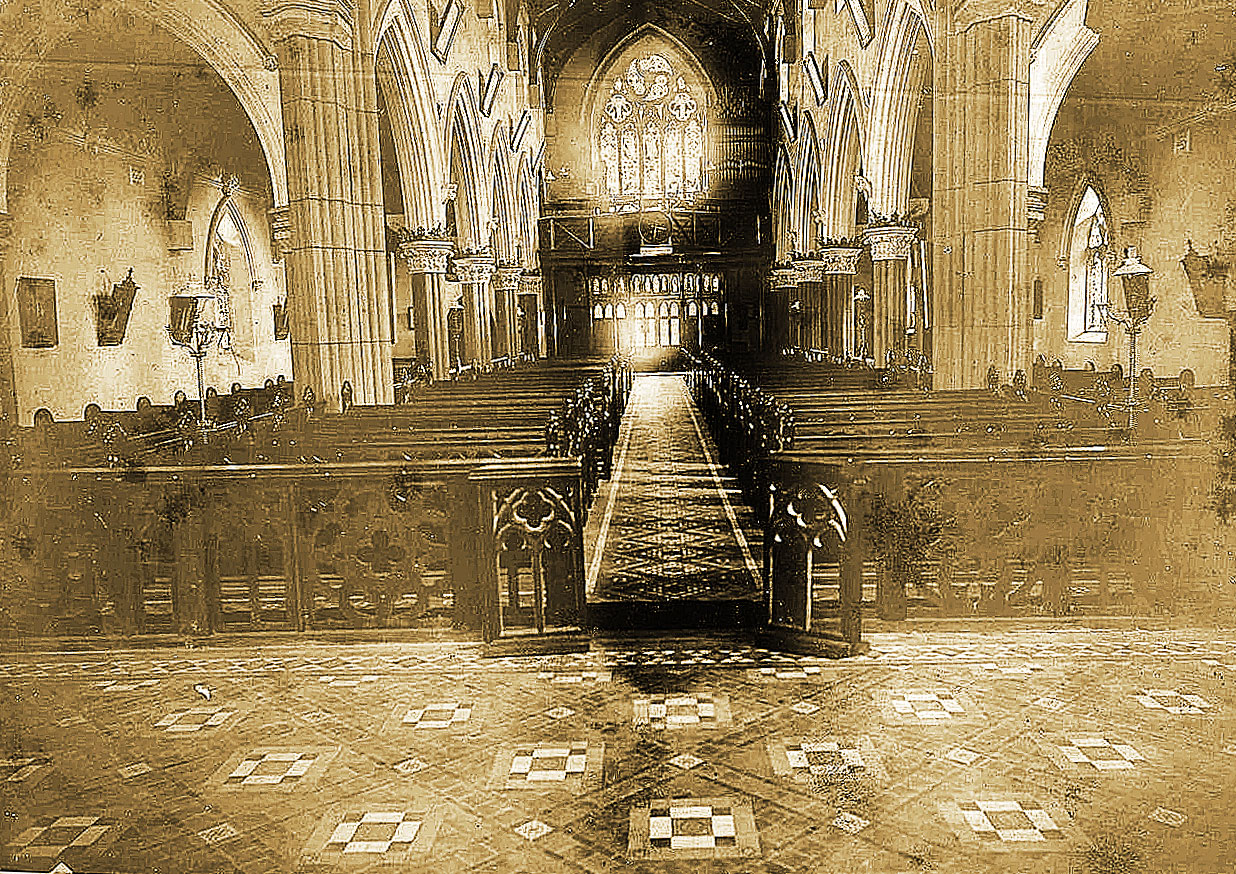
Church of the Immaculate Conception, Hawthorn: interior looking to the rear, organ on the right,
taken after completion of the crossing and sanctuary in 1892
(photograph kindly supplied by the Jesuit Archives, Hawthorn)
A new organ for the church was built in 1879 by Richmond organbuilder George Fincham and placed on a rear gallery where it was placed to face across the gallery to avoid obscuring the large central window made by Mayer of Munich. The façade pipes were elaborately stencilled in colours and gold and there was a separate row of pipes on the right-hand side of the organ, facing down the church.
NEW ORGAN
The opening of the new organ at the Roman Catholic Church of the Immaculate
Conception, Hawthorn, took place yesterday morning at High Mass, which began at 11
o'clock. Mass was celebrated by the Rev. Father Mulhall, assisted by the Rev. Fathers
Watson and Doolan, deacon and sub-deacon respectively. The music for the occasion
consisted of the "Kyrie," from Mozart No.12; "Credo" and "Et Incarnatus," from Haydn No. 8 and "Sanctus," "Benedictus," "Agnus Dei," and " Dona Nobis," also from Mozart No. 12. These were rendered by an efficient choir, conducted by Herr Siede. The soprano solo voice was well represented by Mrs. Smythe, who also sang " O salutaris," composed by the late F. Towers. The Rev. Michael Watson, S.J., who preached the sermon, took or his text the 150th Psalm, commencing "Praise ye the Lord." In applying these words to the mission of the church in directing the religious duties of her people, he showed how she had called to her aid the fine arts for the exaltation and refinement of the mind in the act of worship, and how in this connexion music had been peculiarly consecrated ever since the time of earliest record. The discourse was one specially adapted to the occasion, and was brought to an end with a most eloquent peroration. The "Laudate" of Zingarelli terminated the service, during which Mr. O'Gorman, of Emerald hill, displayed the quality of the new instrument in a satisfactory manner. The organ is from the manufactory of Mr. George Fincham, of Bridge-road, Richmond, and contains two manuals, namely, "great" and "swell" - the compass in each case being from CC to G - 56 notes. The various stops are as follows, namely, in the great :-1, open diapason 8ft. metal ; 2, claribella 8ft. wood ; 3, dulciana 8ft. metal ; 4, principal 4ft. metal ; 5, flute 4ft. wood ; 6, twelfth 2 2/3ft. metal ; 7, fifteenth 2ft. metal. In the swell - 8, open diapason 8ft. metal ; 9, stopped diapason 8ft. wood ; 10, gemshorn 4ft. metal ; 11, piccolo 2ft. wood ; 12, oboe 8ft. metal. The pedal organ bourdon 29 pipes wood CCC to E 16ft. tone. Total number of pipes 701. Couplers swell to great ; great to pedal ; swell to pedal; and three composition pedals in great . All metal pipes of spotted metal. The appearance and tone of the instrument were pronounced to be quite satisfactory.5
The specification of the 1879 organ was:
GREAT
Open Diapason
Clarabella
Dulciana
Principal
Flute
Twelfth
Fifteenth
Swell to Great
SWELL
Open Diapason
Stopped Diapason
Gemshorn
Piccolo
Oboe
PEDAL
Bourdon
Great to Pedal
Swell to Pedal
|
8
8
8
4
4
2-2/3
2
8
8
4
2
8
16
|
|
|
Compass: 56/29
3 composition pedals to Great
Work was subsequently carried out by local organbuilder E. Cornwall Cook who made alterations to the action and pipework.6
Edward Cornwall Cook was born in Cheshire in 1864 and arrived in Victoria on 29 April 1883.7 It is not known whether he trained as an organbuilder before his arrival. In 1889 he was declared insolvent.8 His premises were located in Barrington Place, off Burwood Road, Hawthorn. He built at least three new organs in Victoria for the Presbyterian Churches at Echuca and Daylesford and the Methodist Church, Denham Street, Lower Hawthorn. He worked upon the organs at St Francis' Church, Melbourne and St Paul's Church, Ballarat. He later moved to NSW and was living in Milsons Point, Sydney in 1911 and engaged there as an organbuilder.9 He was also choir conductor at St Francis Xavier's Church, Milsons Point. He died in 1915 at St Leonards, NSW.
In 1902 Geo.Fincham & Son carried out restoration work to the pipework and action.10 Adelaide organbuilder J.E. Dodd worked on the organ in 1923 and is thought to have moved the instrument from the rear gallery to the newly constructed choir and organ loft at this time.11
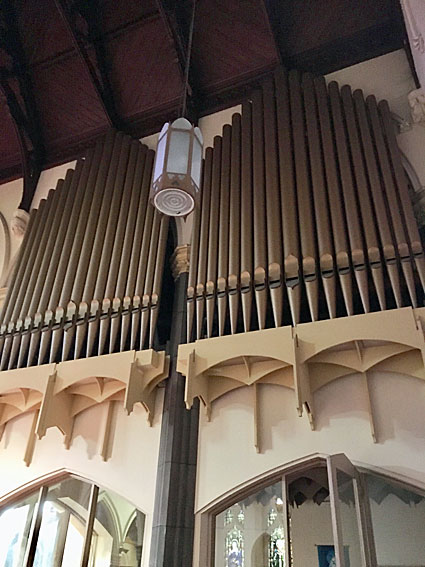
Church of the Immaculate Conception, Hawthorn: organ façade in transept
(photograph by John Maidment [May 2019])
In 1965, the organ was extensively rebuilt and enlarged by Geo.Fincham & Sons Pty Ltd. Electro-pneumatic action and a detached stopkey console were provided. The organ was moved to the front of the organ loft and the new façade consisted of zinc pipes from the 1880 Grand Organ built for the Exhibition Building by George Fincham removed in 1965. The only parts of the 1879 organ that were retained, apart from the pipework, were the two slider windchests. The action, wind system, blower, swell box, and internal framing were entirely new. The Great Organ was placed behind the left-hand pipe façade and the Swell Organ to the right.

Church of the Immaculate Conception, Hawthorn: console
(photograph by John Maidment [May 2019])
Tonal additions included:
GREAT
Double Open Diapason 16 unit of 85 pipes
SWELL
Horn 8 and Mixture 3 ranks (placed on unit chests)
PEDAL
Extension of Bourdon and derivation of Great Double Diapason
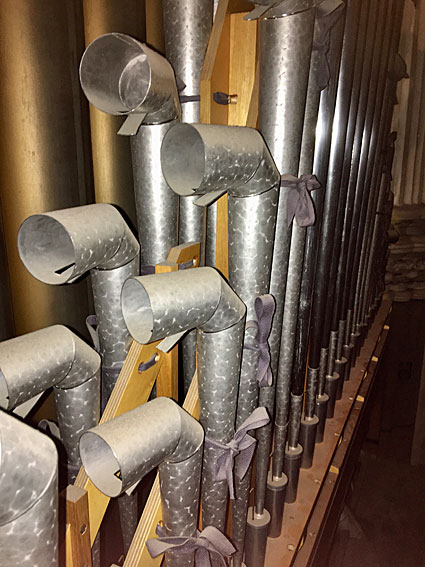
Church of the Immaculate Conception, Hawthorn: Trumpet rank
(photograph by John Maidment [May 2019])
The Fritsch memorial Trumpet 8 was added to the Great Organ in 1983 by Geo.Fincham & Sons Pty Ltd and voiced by Michel Alcouffe. This failed to integrate with the remainder of the pipework and was replaced in 2001 with a new English-style Trumpet made by Australian Pipe Organs Pty Ltd. In the preceding year, 2000, Australian Pipe Organs overhauled the slider windchests, installed new electro-magnetic stop machines, and cleaned the instrument.12
The current specification follows:
GREAT
Double Diapason 16
Open Diapason no 1
Open Diapason no 2
Claribel
Dulciana
Principal
Octave
Flute
Twelfth
Fifteenth
Trumpet
Swell to Great Sub
Swell to Great
Swell to Great Super
|
16
8
8
8
8
4
4
4
2-2/3
2
8
|
A
A
A
|
|
SWELL
Open Diapason
Stopped Diapason
Gemshorn
Piccolo
Mixture 19.22.26
Horn
Oboe
Sub Octave
Unison Off
Octave
Tremulant
|
8
8
4
2
3 rks
8
8
|
|
open wood bass
placed on elevated chest
black metal resonators with pepper-pot caps
|
PEDAL
Open Diapason
Bourdon
Principal
Bass Flute
Octave Quint
Fifteenth
Octave Flute
Great to Pedal
Swell to Pedal
|
16
16
8
8
5-1/3
4
4
|
A
B
A
B
B
A
B
|
|
Compass: 61/30
Detached stopkey console
Electro-pneumatic swell pedal
Electro-pneumatic key and stop action13
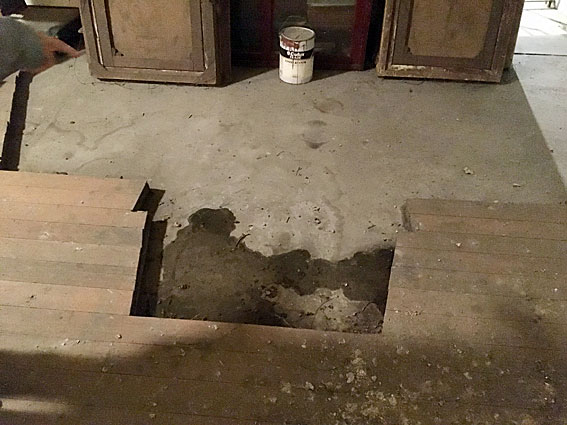
Church of the Immaculate Conception, Hawthorn: cut out floor for the 1879 organ in organ loft
(photograph by John Maidment [May 2019])
The site of the original organ at the rear of the organ loft is clearly evident still with the floor cut out for its placement. An opening for the inlet from the electrical blower, placed high up on the wall to the right, has been filled with loose bricks.
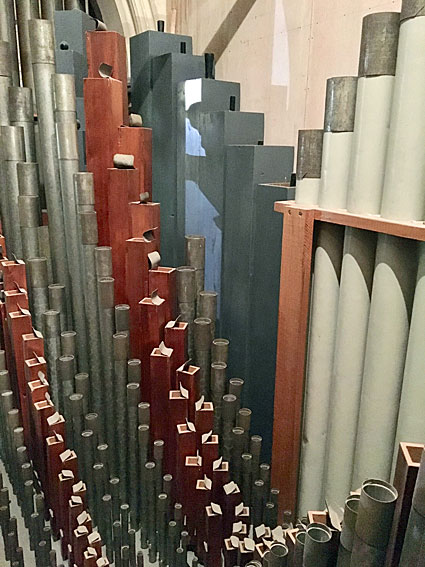
Church of the Immaculate Conception, Hawthorn: Great pipework
(photograph by John Maidment [May 2019])
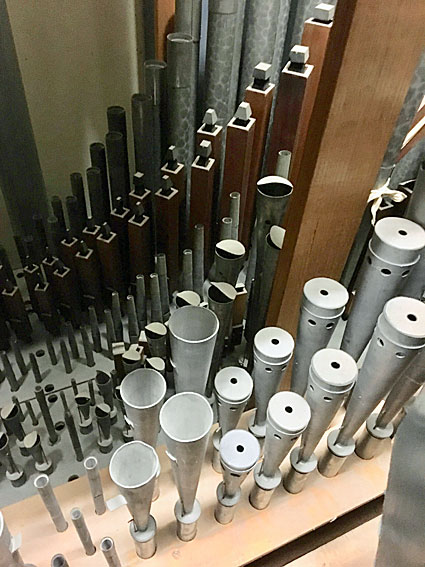
Church of the Immaculate Conception, Hawthorn: Swell pipework
(photograph by John Maidment [May 2019])
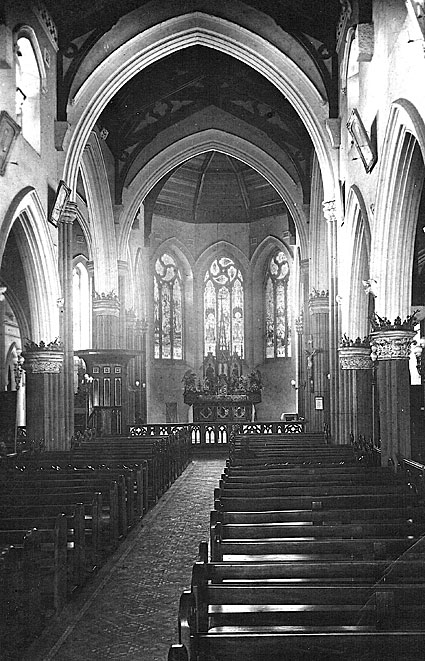
Church of the Immaculate Conception, Hawthorn: interior
(photograph from a postcard dating from c.1911)
1. Illustrated Australian News for Home Readers, 16 May 1869, p.4
2. Advocate, 10 December 1892, p.10
3. Ibid., 4 October 1913, p.18
4. Ibid., 10 August 1922, p.16
5. Argus, 15 December 1879, p.6
6. E.N. Matthews, Colonial Organs and Organbuilders (Carlton: Melbourne University Press, 1969), p.137
7. Cook Family Archive: http://www.forum.familyhistory.uk.com/archive/index.php/t-15900.html
8. The Argus 23 November 1889 p.12
9. Sydney Morning Herald 16 September 1911, p.27
10. Matthews, op.cit., p.137
11. J.E. Dodd correspondence, derived from Bruce Naylor, 'J.E.Dodd – a Romantic Organ Builder', based upon a talk given at the OHTA conference, 30 August 1980, Adelaide, https://ohta.org.au/wp-content/uploads/JE-Dodd-A-Romantic-Organ-Builder.pdf
12. Information provided by Robert Heatley, Australian Pipe Organs Pty Ltd, May 2019
13. Specification noted by John Maidment, 1965, 2019









